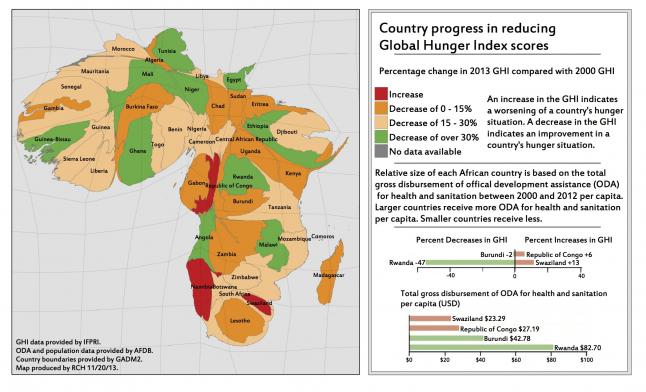With the 2015 deadline for achieving the Millennium Development Goals fast approaching, the 2013 Global Hunger Index (GHI) released by the International Food Policy Research Institute in October affords a prime opportunity to evaluate progress to date related to hunger alleviation and health outcomes. Comparing the GHI performance of African countries with aid flows per capita and political commitments to hunger and nutrition suggests that politics may trump aid when it comes to influencing progress in reducing hunger.
The Global Hunger Index assesses 120 countries against three equally weighted indicators - global undernutrition, child mortality, and child underweight - utilizing data sourced from the FAO, WHO, UNICEF, and other relevant UN agencies. GHI countries have made significant progress overall since 1990, most notably in Sub-Saharan Africa with a reported 23% reduction in hunger regionally. Nonetheless, subregional analysis reveals significant inequities across nations and individual countries with scores that remain "unacceptably high".
The map below illuminates Africa's GHI performance over the last decade in terms of official development assistance (ODA) flows per capita. While the continent has made at least marginal improvements in health and nutrition outcomes, there is considerable variation between countries which suggests that donor commitment alone may not consistently determine improvements. Despite sharing a common border, Rwanda and Burundi represent a best and worst case, respectively, in their GHI outcomes according to the 2013 index. Rwanda has made significant improvements in reducing hunger since the original 1990 index, while Burundi remains a location of critical concern - one of the few countries where current GHI scores are categorized as "extremely alarming." The GHI report makes concessions for Burundi due to the geopolitical struggles generated by its large, conflict-ridden neighbor the Democratic Republic of the Congo, but Rwanda faces the same external upheaval on its border with similar internal conditions. Somehow Rwanda seems to have overcome these geopolitical impediments and to sustain momentum in eradicating hunger that has, thus far, eluded Burundi. A side-by-side comparison between the two countries offers a unique case study in hunger reduction strategies under similar social and geopolitical constraints.

As the visualization above suggests, Rwanda has enjoyed a substantially more generous flow of aid over the last decade - suggesting that ODA levels do bear some weight on development outcomes. However, the differences between the two nations are not just an issue of dollars and cents. Cross-referencing GHI outcomes and aid flows with Hunger and Nutrition Commitment Index (HANCI) scores provides an intriguing insight into the relationship between governance and policy with nutrition outcomes. HANCI measures a government’s political commitment to hunger reduction in three key areas - policies and programs, legal frameworks, and public expenditures. Comparing Burundi’s and Rwanda’s HANCI scores, Rwanda demonstrates a significantly higher political commitment to ending hunger and malnutrition. As a result, a narrative begins to emerge. Since the tragic events surrounding the genocide in the 1990s, Rwanda's policy choices have been significantly different than those of Burundi. President Kagame instituted community based health and nutrition initiatives, and the country continues to cooperate with the WHO and other key stakeholders to improve health outcomes. While Burundi has made some progress with health care delivery - including the recent launch nationwide of a results-based finance scheme - the road forward is a long one. The same dynamic which has made Rwanda and Burundi an important case study in their differences presents a measure of hope for the future. Rwanda is a dramatic example of the kind of progress that can be achieved post-crisis in the right policy environment.
